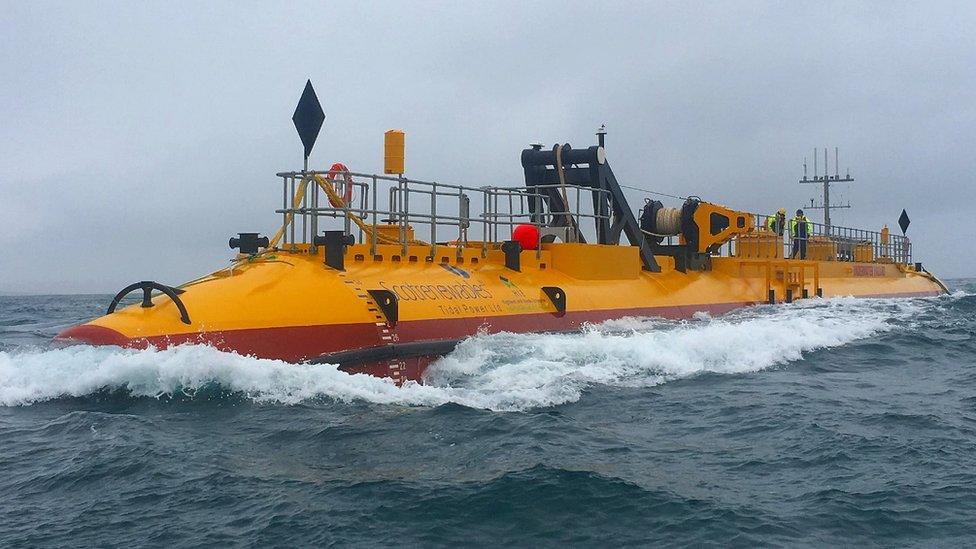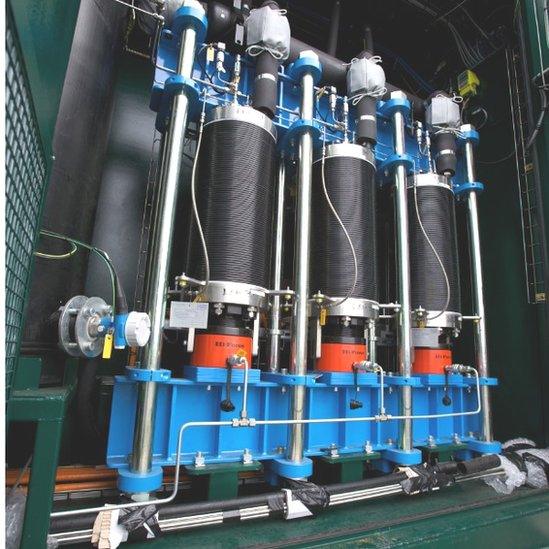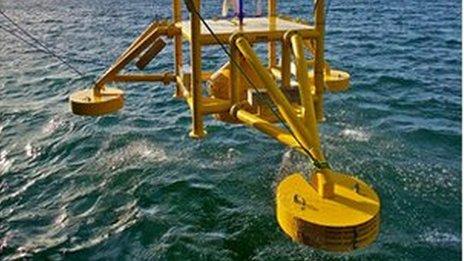Tidal energy site in Orkney in hydrogen 'first'
- Published

Scotrenewables' prototype tidal energy converter - the SR2000 - was involved in the first production of hydrogen
A Scottish test and research centre has claimed a world "first" by generating hydrogen gas from tidal energy.
The European Marine Energy Centre (Emec) said it achieved the feat at its tidal energy test site in Orkney late last month.
It added that it demonstrated the potential for a clean replacement for polluting fuels.
Emec's investment in hydrogen production capability was backed by the Scottish government.
Funding of £3m was made available through Highlands and Islands Enterprise.
The hydrogen gas was produced after prototype tidal energy converters - Scotrenewables' SR2000 and Tocardo's TFS and T2 turbine - fed power into an electrolyser situated next to Emec's onshore substation.
Supplied by ITM Power, the electrolyser used the electricity to split water (H2O) into its component parts - hydrogen (H2) and oxygen (O2).

Tidal energy converters fed power into an electrolyser situated next to Emec's onshore substation
Energy Minister Paul Wheelhouse said: "The Scottish government is pleased to be supporting this innovative project, which will help to partially overcome grid constraints in the Orkney Islands by enabling the storage of excess tidal power generated and using that electricity to produce hydrogen.
"The project also adds to our growing understanding of the potential role of hydrogen in Scotland's future energy system - something we have committed to exploring in our draft Energy Strategy."
'Tremendous milestone'
Emec managing director Neil Kermode described the development as a "tremendous milestone".
He said: "The electrolyser was set up to pilot the production of hydrogen fuel from tidal energy - and now we've done just that.
"Whilst the initial driver behind buying an electrolyser was to provide a storage solution to circumvent local grid constraints, the purchase has sparked off other pioneering projects around Orkney looking to use hydrogen in various means.
"So we're now looking towards the development of a hydrogen economy in Orkney."
Surf'n'Turf project
There are plans to use Emec's electrolyser for a number of projects, including one led by Community Energy Scotland in partnership with Orkney Islands Council, Emec, Eday Renewable Energy and ITM Power.
The Surf'n'Turf project will involve the electrolyser producing hydrogen using electricity from Emec's test site as well as power from a 900kW wind turbine owned by the Eday community.
The hydrogen will then be transported to Kirkwall, where a fuel cell installed on the pier will convert the hydrogen back into electricity for use as auxiliary power for ferries when tied up overnight.
The project is also developing a training programme with a view to green hydrogen eventually being used as a fuel source on the inter-island ferries themselves.
Mr Kermode added: "One of the most promising uses of hydrogen is as a fuel for transport as it emits no carbon when it is consumed and, providing it's generated by clean renewable energy sources, it becomes a carbon neutral fuel source.
"Therefore, we could see green hydrogen, over time, replace polluting fuels in our cars, vans and ferries."
Related topics
- Published14 April 2017
